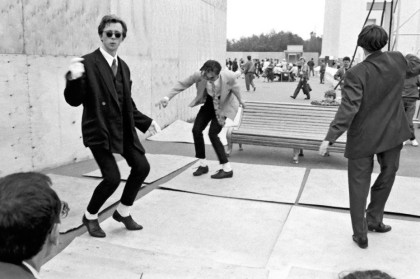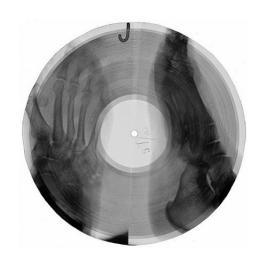
The death of Joseph Stalin in 1953 created a culture vacuum in which the anti-communist styles and values of the West attracted the millennial generation of the Soviet Union. The uniformity of the Stalinist era focused on collective accomplishment, whereas the new wave of the Stilyaga revitalized the idea of individualism for both men and women. Starting in Leningrad, the movement quickly found its way to Moscow, which created a domino effect in Soviet youth circles. These Soviet rebels “were the inverse image of the Stalinist society of their fathers’ generation. The fathers wore baggy trousers, so the sons cut theirs narrow . . . the fathers denounced the wicked West, so the sons embraced it” (Richmond, 2010, p. 172). Stilyaga, Zoot Suiters, and Style Hunters were all titles given to those who indulged in this cultural rebirth that promoted Western style, music, and jargon. The influence of America’s Broadway could be observed in the extemporaneous street dancing, colorful clothing, and live music night clubs that promoted Western music like rock ‘n’ roll and jazz. Ultimately, the Stilyaga were fixed on changing Soviet style, not politically revolutionizing the state.
He lives off his parents and ‘burns’ his money in restaurants . . . He ‘adores’ everything foreign and is ready to give his right arm for a fashionable record. He thinks nothing of deceiving a girl and he boasts about it. He likes to dance, dumbfounding the public with his magnificent steps. He is disillusioned with life. – Ye. Rusakova, Which of Them is a Stilyaga? (1956)

From those outside the group, the main concern was the Stilyaga’s ability to become “role models for future émigrés, rockers and discontents,” and the term Stilyaga soon became a negative label due to state-sponsored propaganda (Seventeen Moments in Soviet History). This particular movement predominately attracted the privileged, because the children of the intelligentsia at the time were sent to private English-language schools. In a push for a professionally competitive generation, “the parents did not realize that, in the process of learning a Western language, their children would also be westernized” (Richmond, 2010, p. 173). This suggests that the rise of the Stilyaga was the result of a systemic educational shift in the upper class in addition to the absence of Stalinism. There had been tremendous social pressure to follow norms, but the Stilyaga were purposeful and public in their promotion of foreign lifestyle. Girls, just like the boys, challenged the norms that existed in Soviet life. Similar to how male clothing became tighter, female Stilyaga clothing was said to “cling to the point of indeceny. Her skirts are slit. Her lips are brightly painted, She wears ‘Roman’ sandals during the Summer” (Richmond, 2010, p. 172). However, deeper and more significant than their appearance was a desire to romanticize rebellious behavior in ways that exempted them from state backlash, which under Stalin, made the “blind worship of the West” punishable by law (Kaganovsky & Salazkina, 2010, p. 261).

It was simply not enough to look like the West, they had to live like the West. For example, music was limited in the Soviet Union, both in genre and supply. Music itself came with a culture of its own, as it became the soundtrack to American film, promoted the idea of night clubs, and created fashion trends. Western jazz symbolized free-flowing, improvisation and rock ‘n’ roll projected raw emotion full of American slang. Western records were difficult to acquire in the Soviet Union, and the Stilyaga went to great lengths to collect rare albums even if they were bootlegs. The high demand forced a creative solution: “the homemade record, known as ‘rock on bones’ or ‘rock on ribs’ (rok na rebrakh), was a true Soviet invention: a combination of a lack of raw materials and pure ingenuity” (Kaganovsky & Salazkina, 2010, p. 261). Hospital dumpsters and construction sites were raided for old x-rays and road signs that could be pressed into records, and these “Bone Records” provided the listener a unique listening experience sonically and visually. Music aside, the Stilyaga began an important and controversial cultural awakening among youth that Westernized style, challenged norms, and sparked individual creativity in a state that had preached social discipline and anti-Western values.
 This post received a “Red Star” award from the editorial team
This post received a “Red Star” award from the editorial team
Sources:
Kaganovsky, L., & Salazkina, M. (2014). Sound, Speech, Music in Soviet and Post-Soviet Cinema. Indiana University Press. https://books.google.com/books?id=957xAgAAQBAJ&pg=PA261&lpg=PA261&dq=soviet+stilyagi&source=bl&ots=DtmKeDN1wO&sig=eLFwDEvDbk214K3-Y1NrMvNOGKA&hl=en&sa=X&ved=0ahUKEwigpcSir9_LAhWKWh4KHejFCBg4ChDoAQg_MAY#v=onepage&q=soviet%20stilyagi&f=false
Photos:
http://www.leisurefeat.com/hipsters/hipsters.jpg
http://www.aux.tv/wp-content/uploads/2014/08/3032206-slide-xray4.jpg

I really enjoyed this article. Seems like these Zoot Suitors were hipsters for their era. The style was so different between music, clothes, and an adoration with the west. Really cool!
LikeLike
Wonderful post. The Stilyagi movement was huge and really captures just how “big” the thaw was in some regards. These teenagers were the future of the Soviet Union and they were already wanting a more westernized culture. While it was still nearly four decades away, some of the mindset that was established with the thaw would lead to the collapse of the USSR.
LikeLike
I knew that you would be the one to take on a Stilyaga post this week! Awesome work as always, and I am especially fond of your section on x-ray records. You might want to check this out! http://www.npr.org/2016/01/09/462289635/bones-and-grooves-weird-secret-history-of-soviet-x-ray-music The process of buying a bootleg record as described in the podcast is hilarious!
LikeLike
Your post was great. It was very informative and it made me want to keep reading. The pictures you used were really cool. It’s surprising just how popular the Stilyaga movement was.
LikeLike
This is a really great post! I did some research on the Stilyagi in the past and found them to be really interesting. The creation and the treatment both paint a picture of the time period that the Stilyagi were created. The movie is really good and I suggest that you take some time to watch it. Yes, it is in Russian, but the language doesn’t stop how good it is. It is all on youtube.
LikeLiked by 1 person
The activities of non-conformist youth of the 1950s is a great counter-point to the dominant themes of this era — cold war rivalries and the space race. Clothing, dancing, and especially music were spheres where Soviets sought to emulate Western style — at the same time that new technologies, like records, gave them some freedom to re-create these styles at home.
LikeLike
I liked how this post really showed how the youth of the Soviet Union broke out of the cultural norms of the time.
i liked that you made the connection between their English language education and their infatuation with the west.
LikeLike
In addition to what everyone noted, I want to add that I really appreciate how this post suggests that cultural expression has political implications – and the irony that the Stilyagi professed to NOT be political at the same time they ruffled the status quo of their privileged parents and system they represented is wonderful.
LikeLike